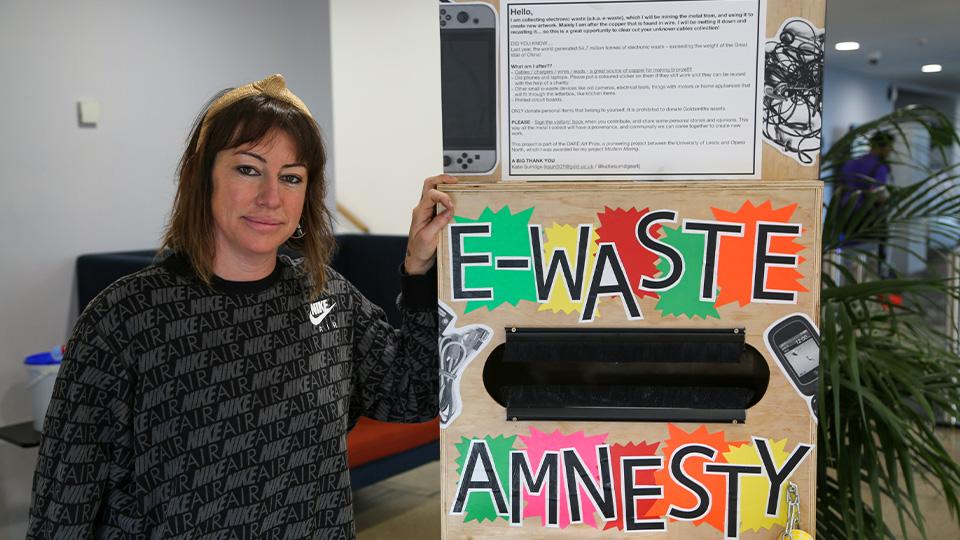Blending science with art to tackle electronic waste
Primary page content
A Goldsmiths student has found an innovative way to combat electronic waste, by installing e-waste recycling bins on campus and using the donated materials to create new sculptures.

Katie's e-waste bins are located at the Library and Richard Hoggart Building entrance.
A creative solution to the global problem of electronic waste could begin at home, says MFA Fine Art student Katie Surridge.
Katie is encouraging students, staff and members of the public to delve into their drawers of mystery cables and broken electricals and donate any unwanted items to her latest project, which gives a new life to valuable elements trapped in electronic devices.
Sculptor Katie has been awarded the £15,000 Dare Art Prize 2022-23, a partnership between the University of Leeds and Opera North, which challenges artists and scientists to collaborate on new approaches to the creative process.
Katie’s year-long commission addresses the mounting problem of e-wase, which grew to 57.4 million metric tonnes in 2021, with annual wastage growing by an average of two mt per year.
Katie said: “I am collecting electronic waste which I will be mining the metal from and using it to create new artwork. Mainly I am after the copper that is found in wire. I will be melting it down and recasting it… so this is a great opportunity to clear out your unknown cables collection!”
Disused electricals can be donated to the e-waste amnesty boxes, which have been installed on campus at the Library and Ben Pimlott Building.
Katie then plans to break down the objects, and through a biological process using microbes, extract a metal-rich liquid which will be used in the production of new sculptures.
Explaining the process, Katie said: “Bioleaching, or biomining, is a process that uses microorganisms such as bacteria to extract valuable metals. I plan to learn more about this method to ‘mine’ metals from the devices that are submitted by the public. A metal-rich solution is produced as a result of the bacteria’s actions, and I hope to be able to transfer these metals to my artwork through electroplating.
“I have an aversion to modern technology and my work is often inspired by folklore, stories and skills from the past. My last major body of work involved making my own iron from ore, but my DARE project has transported me from the Iron Age back to the present, and the problems faced by society today.
“The distant past is always a big influence on me, though, and one of the sculptures that I’m planning to make with the recovered metal is inspired by a 1200 BC ‘oxhide’ copper ingot that I discovered in the British Museum. I was drawn to the combination of beauty and utility in its form, which resembles an ox’s skin stretched out to dry, and which also made it easy to carry by hand, to load onto pack animals or to stack in a ship’s hold in the Bronze Age Mediterranean”.
Donors are asked to drop in their cables, chargers, wires, leads, phones, digital cameras, or anything with a motor or a circuit board into the brightly coloured e-waste bins, and fill out the stories behind the item, how it was used or why it was discarded, in the visitor book.
You can follow along with Katie’s progress on her blog.